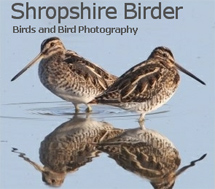Weekly round-up: 13 - 19 Nov 2013
The week ended with the first truly chilly nationwide burst of Arctic air ~ the weather men and women beside themselves over the impending “weather event” that was on the way ~ as a northwesterly airflow filtered down across much of the country bringing wintery showers on brisk winds ~ all rather typical mid-November conditions.
Prior to this first true glimpse of winter, conditions had been relatively benign. Nothing significant came our way, the winds generally from the west with attendant damp spells too. There wasn’t much to get excited about….
…luckily though, after a quiet week, this new seven day period had lots of things within it by way of things to get excited about.
So last week’s opening rambling gambit waffled on about imaginary mice in imaginary slippers on imaginary duvets by way of attempting to convey the general air of quiet and calm that had descended over the place that we know and (sometimes) love as the birding world.
This week, the mouse has taken off those slippers and gone for full-on hob-nail DM’s, stomping about over a corrugated roof to make one heck of a racket.
There wasn’t time for the hard workers who bring you your news at the RBA HQ news-coalface to have time to think of having it easy now that December becomes closer than October, no, no, no…! This was a busy week, a very busy week with a cracking mega to get the juices flowing and open up the file named “ID discussion” and the Grade A top-of-the-class bird was followed by another soon after with an invigorating supporting cast following on, a supporting cast which was of a particularly high-calibre.
Leading the way the presumed Western Orphean Warbler that emerged from the Internet shadows on Thursday evening (14th) after sharp eyes picked up the fact that the bird initially thought to be a Lesser Whitethroat on the (ever-excellent) Pembs Bird blog (pembsbirds.blogspot.co.uk) was actually an Orphean Warbler.
The bird had been noticed by Peter and Rosemary Royle, feeding in the trees of in their garden at Orlandon Kilns, near Marloes (Pembrokeshire) on 10th and it was their blog post that set the ball rolling later in the week.
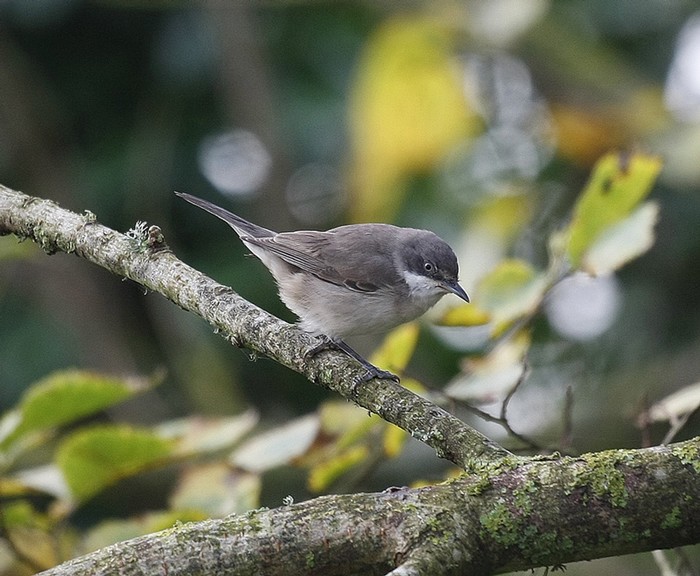
Fortunately, not only where they, and the rest of the village, particularly accommodating, the bird was too (generally) and it showed on 15th, 16th and 17th to appreciative crowds, some of whom had missed the Western Orphean Warbler in Cleveland in May 2012 and some of whom were there with hopes of Eastern Orphean Warbler on their minds…
The two photos that Peter and Rosemary Royle posted clearly showed an Orphean Warbler but assigning it to race, from the two shots available that evening was borderline, but clues were there.
Here’s more on the exciting discovery from local Pembrokeshire birder Dave Astins…
It’s been a busy few days in Pembrokeshire! On the morning of Sunday 10th November, Rosemary Royle saw a Sylvia warbler feeding in the small apple trees in her garden at Orlandon Kilns, between St. Brides and Marloes. She, and husband Peter, thought it was a Lesser Whitethroat, and mentioned it in a post on the Pembrokeshire Birds blog early afternoon entitled “Another November Warbler” (in reference to 2 Yellow-browed Warblers that had been found during the week).
At some point late that afternoon, whilst out birding in the Marloes area with Paul Grennard, I received a text from another local birder, Adrian Rogers, alerting me to Rosemary’s blog post and suggesting it might be interesting due to the late date for this species. I agreed, but perhaps at that point should have called by the Royle’s house and asked if we could take a look! Anyway, that evening I made mention of it potentially being “very interesting” in my own post on Pembrokeshire Birds. Little did I know just how interesting it would prove to be! Independently, Mike Young-Powell had also seen the post and e-mailed the Royles stating that it could be an interesting race of Lesser Whitethroat, and suggested they should try and get some photos of the bird.
For various reasons (detailed nicely by Rosemary on the Marloes & St. Brides web-site - www.marloes.org.uk), it wasn’t until Thursday morning that Peter was able to obtain some excellent photos from their kitchen window and post them to Pembrokeshire Birds just before midday. Unusually for me I didn’t have lunch at my desk that day, so did not check the blog as I usually do and see the photos, but when Mike did check the blog around 6pm he was struck by the pale iris and heavy bill. He started thinking seriously about Orphean Warbler, so began checking literature, and whilst doing so received an email from a friend, Robin Hemming, who also queried the pale iris, which spurned Mike on to further research.
Having narrowly avoided burning the dinner, Mike took a call shortly after 7pm from Richard Brown, Skokholm Warden, who had just seen the pictures on the blog and was sure it had to be an Orphean. Mike and Richard discussed the identification, and buoyed by his discussion with Richard, who was willing to put his name to this brave call along with Mike, the post was placed onto Pembrokeshire Birds….and then all hell broke loose. I, meanwhile, came out from a swimming session at 8pm to be met by several missed calls from both Mike & Richard, and several texts telling me to check the Blog: we had an Orphean on our hands, a first for Wales and just the 7th for Britain.
Almost before we could gather our thoughts, several calls were being made and discussions were had before access was arranged. Brilliant! After initially thinking that the best way to view was from inside the house in groups of 6, Peter decided to allow viewing from the parking area within the garden and on the Friday morning some 45 birders, including myself and Mike, gathered and were treated to three brief views of the bird within half an hour of first light. We’d nailed it! As the day progressed perhaps 90 birders came, less than we were expecting, but the arrangements worked well. A few refinements were needed for the Saturday and Sunday when greater numbers were expected, to minimise disturbance to the bird and to maximise the opportunity to see it for everyone who came. Peter and Rosemary asked visiting birders to donate towards the Skokholm Island Restoration Fund, and were delighted with the £736 raised over the three days.
The highest number at any one time was first light on the Saturday, with around 110 people assembled, but the bird showed well and using a rotation system everyone managed to see the bird fairly quickly and queued up for a second view if they wished, which many did. We estimated perhaps 400 people came to see the bird over the three days, with many returning for a second look as well. Many went off nearby to enjoy a flock of Lapland Buntings on Dale Airfield, and of course Choughs which are pretty easy to see on this peninsula.
At the time of writing there is much debate as to whether this is an Eastern or Western Orphean. The majority seem to favour Western for many reasons, including the brownish tones to the mantle, warmish wash to the underparts including the flanks and undertail coverts, and lack of dark markings on the undertail. Perhaps the key lies in correctly ageing the bird – I and many others believed that a bird with such a pale iris could not be a first calendar year bird, but this may not be the case. If it is an adult, then the plumage would suggest a female bird. If it is a first year, then it is perhaps a first year male. I will be interested to see what the final verdict is!
As you can imagine Pembrokeshire Birds, set up by Richard Crossen (and a model in how a county level blog can work), received a significant increase in hits following the first post. The daily average is around 1,000 hits, which is great, but 5,699 were recorded on the Thursday and another 6,938 on the Friday! Richard himself couldn’t get on the blog on the Friday morning, possibly due to the volume of traffic.
The Orphean Warblerhas capped a wonderful year for rare and scarce birds in Pembrokeshire. In the 25 years I have lived and birded here, I can recall several years where I have not seen a single BBRC species. This year has been the complete opposite. The rare bird list for the mainland alone has included Long-billed Dowitcher, Surf Scoter, Ring-necked Duck, Semipalmated Sandpiper, Lesser Yellowlegs, Black-headed Wagtail, Glossy Ibis, 2 probable Citrine Wagtails, Isabelline Wheatear, Subalpine Warbler, and Woodchat Shrike to name but 11. The islands weighed in with 2 Booted Warblers, a Pallid Harrier, a Western Bonelli’s Warbler and a Blyth’s Reed Warbler (none of which I managed to see).
Pembrokeshire is incredibly underwatched, the track record hints at the potential but it is surely ripe for some enterprising birders to work a small area really hard. You’d be very welcome!!
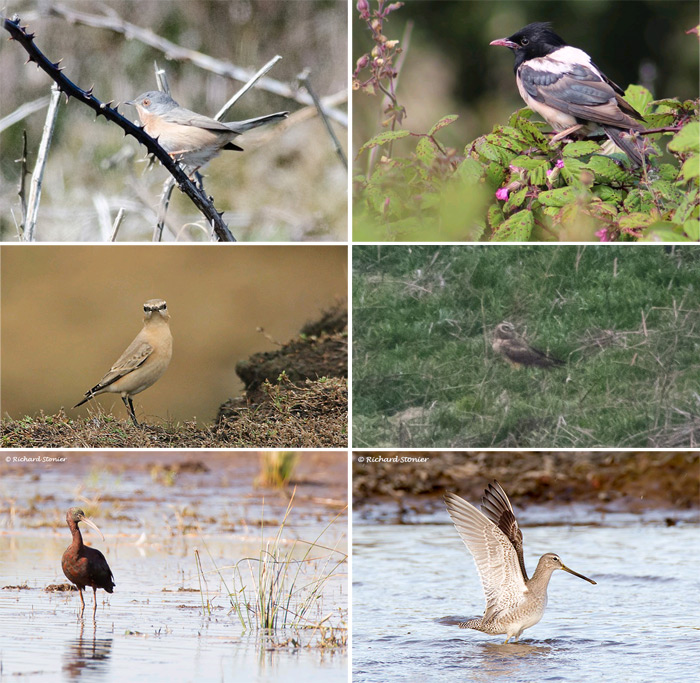
As Dave mentioned, the undertail coverts, though not fully visible at first, gave an initial impression of being clean and unmarked (a Western feature) while (soft feature alert…) the flanks and almost shrike-like feel of the bill also led some to think that this was Western hortensis rather than Britain’s first conclusive Eastern crassirostris as reported by some.
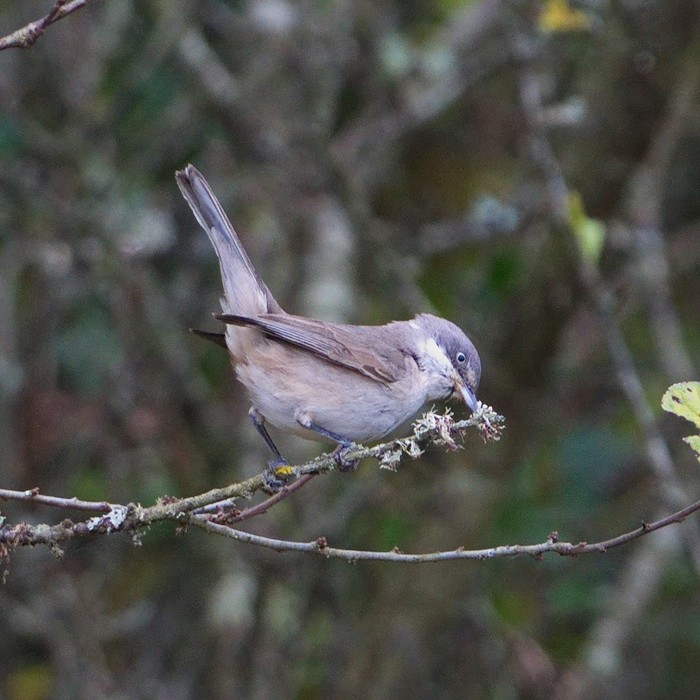
We know that photos are massively subjective and there was a body of thought leaning towards Eastern on that first evening (it was even broadcast as such), but through Friday and Saturday, with some pretty conclusive images forthcoming (certainly of the undertail and also the ghosted tail pattern as seen from below ~ Paul Rowe’s excellent and vary instructive image is worthy of a BBRC award), Western was indeed the correct call (with suitable due caution being exercised) and this was confirmed as every new image came to light online.
The tail pattern still seems to be the clincher for the two species away from respective breeding ranges ~ the Welsh individual really does look as though it has the requisite “Richard’s Pipit” pattern in place. The age appears to be a definite first-winter, but the sex of this clearly pale-eyed hefty beast is one that perhaps could only be determined by in-hand examination.
Last year, we all went crazy for a bird with the WOW factor ~ © me, May 2012 ~ the first-summer male trapped and ringed at Hartlepool Headland on May 29th. Hundreds of folk were able to down tools and scurry to the northeast and just about everyone who made it there went home happy. Being a midweek mega doesn’t help everyone though which makes the appearance of another so soon all the more welcome.
With a little tweak here and there, some of what was written in the wee small hours of May 30th 2012 (always hit a deadline, always hit a deadline…) may be worth trotting out again…
The current Pembrokeshire bird will become the seventh Orphean Warblerto be recorded in Britain and, if everyone finally goes with the flow, just the third to be assigned to a specific species.
Britain’s first Orphean Warbler also a Western hortensis, was trapped and ringed at Portland Bill on September 20th 1955 ~ a bird that, in 2006, saw the BOURC announce that would accept it as a nominate race bird, thanks mainly to a single feather that had been collected at the time and which was then, decades later, sent off for lab analysis. The results of that work suggested that “the DNA was strongly indicative of nominate hortensis”.
Britain’s second Orphean Warblerwas trapped at Porthgwarra in October 1967, and then came the famous 1981 bird on Scilly to make it three. A year later, on October 10th 1982, one was trapped at Seaton Park in Aberdeenshire and then, in May 1991, a three day singing male was in semi-residence in a birder’s garden in Saltash, in southeast Cornwall.
May 2012 (© Paul Hindess)
Which of the four unassigned birds, if any, were Eastern crassirostris is unlikely to ever be resolved, though a dusting down of the BBRC files may offer some clues for the two trapped October birds. Some of the old-guard present at Hartlepool had seen that St. Mary’s bird in 1981 ~ and some of those who saw the Scilly and Hartlepool birds also took a day trip to Wales too, just in case.
The dice was thrown and the roulette wheel spun again as those who chanced their arm went for the classic “ulterior motive” Welsh move ~ and now with the two birds in the space of 18 months being both from the West, the push for Eastern Orphean Warbler as being the answer to the specific ID of the Lower Moors bird remains (once again) in the forefront of their minds for the first of their trio of this uber-rare warbler.
A great bird and, although there’s to be no further access (fair do’s, everyone had a weekend to have a go at scoring ~ not that that stopped some from knocking on the door ~ DOH!) let’s hope that the accommodating house owner’s keep us posted with the bird’s state of play (we know it was still around on 19th).
The Welsh warbler was one of the most popular birds of the autumn, by virtue of being on the mainland for one thing, but it wasn’t the week’s rarest bird ~ that honour went to the moulting first-winter Short-billed Dowitcher found during on 17th on North Ronaldsay (Orkney). A fourth for Britain (out of a grand total of seven if you include Ireland’s trio), it came completely out of the blue…

On Discovery Day, a number of shots were rattled off as the bird fed with Redshanks and Turnstones at Bewan and they were enough to resolve the early puzzle as to which species was involved. Last year’s twosome (in Dorset and on Scilly) appeared within five days of each other in early September and both of these were rather more straightforward to confirm than this mid-November moulter.

Short-billed was the call ~ and after a blank 13 years between the Rosehearty juvenile of September 1999 (which you’ll remember moved to Cleveland) and the Lodmoor and Tresco birds of 2012, suddenly just a year or so further along, we have another. Excellent work, once again, by the Observatory staff ~ proving again that just ‘cause it doesn’t look that good outside, the megas are still on their way…

Years ago, this was always a long-expected species and it actually resided on the British List for a long while after a bird seen at Cley and Salthouse in October 1957 was accepted as Short-billed Dowitcher ~ it was finally reviewed and removed from the list in April 1992 ~ and, interestingly, re-classified as a Dowitcher sp..
It came as little surprise when news of the first filtered out of Wexford in September 1985 of a bird being found at Tacumshin ~ and the juv., in Aberdeenshire felt long overdue when it appeared too. Ireland’s second came along in 2000 and again in 2001 (in counties Meath and Dublin) while the Republic’s third (a first-summer) was discovered at Lady’s Island Lake (also, of course, in Wexford) in June 2004, where it spent over a month and half on site before appearing later in the year in County Dublin, spending the winter on North Bull Island. Then there were none until the Dorset and Scilly birds of September last year, the former attracting a long stream of listers to Lodmoor.
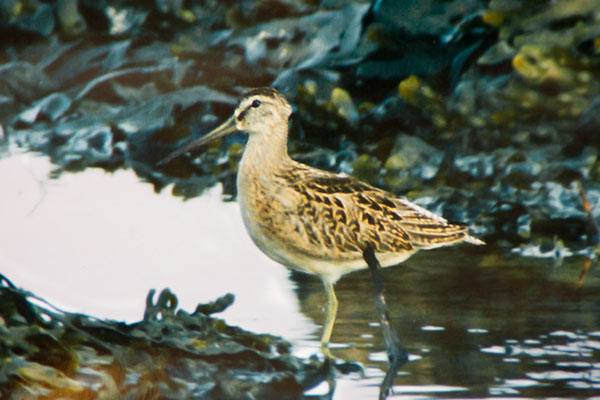
This week’s latest super find for North Ronaldsay’s birders appeared to have been a one-day wonder, with no sign on 18th but as the week drew to a close, it was back on the same stretch of water and showing well ~ where did it go on it’s day off?
Two great, great birds already then and more are on their way…
In Norfolk, causing a little bit of a stir, was the apparent juvenile Thayer’s Gull-type that alighted amongst the pre-roost gathering on Pat’s Pool, Cley NWT during the late afternoon of 13th.
A striking looking thing, the bird sat amongst a bunch of argenteus and argentatus Herring Gulls and stood out like a sore thumb, with a suite of characters in line with those shown by many Thayer’s . Although present early the next day on the same pool (noted by one lone soul, brave enough to take a punt on it appearing before heading off), it wasn’t seen again.
Will it be an acceptable record?
Well, none of the poor images available convey just how good a candidate the bird was and it seems likely that a Records Committee would view it as certainly heading in the right direction but, without the relevant photographic documentation to show precisely the pale underwing, “venetian blind” upperwing, muddy based greater coverts, neat “holly leaf” scaps., so often shown by Thayer’s and more besides (all of which this bird had), then no matter how good the description from the experienced larophiles on site proved to be ~ some of whom have seen several Irish birds and many more in western USA for starters ~ the “NP” buffers or the “Pending” sidings are where it could be heading for…(while the notion that it was one of the hybrids seen over the next few days was some way off the mark).
Interestingly, the three well-documented Thayer’s Gull-types recorded in Britain to date ~ the much debated juvenile at Oxfordshire’s Dix Pit (in December ’07 to January ’08) that relocated to Derbyshire’s Poolsbrook (in February ’08), the presumed adult in Essex, on Pitsea tip in November 2010 and last year’s April juvenile in Lincolnshire all reside in limbo ~ none have been accepted on to the British List so far, although the latter two have at least jumped the first hurdle of acceptance as they now both reside with the BOURC, while the Derbyshire bird is still “IC” (in circulation).
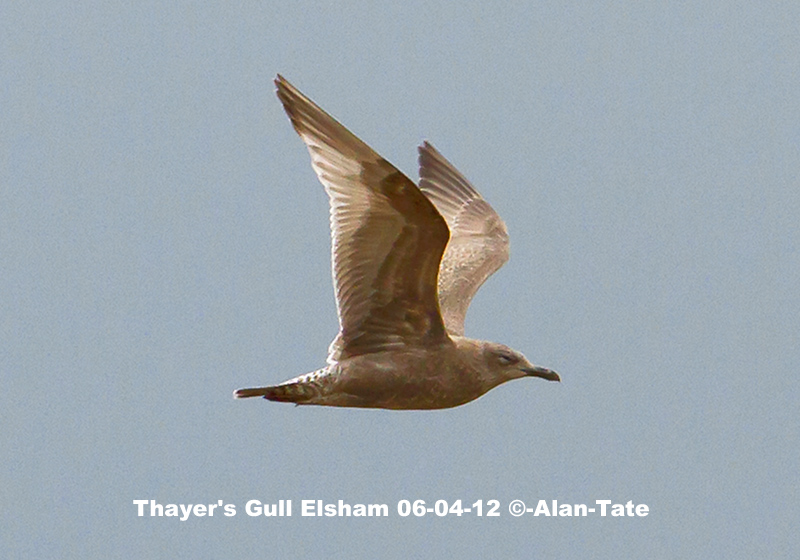
Ireland’s committee has no such qualms, banging eight on to the list in total, from the first (and, arguably, still the best) at Cork City Dump and surrounding area (right over to beautiful Cobh) in February and March 1990 to the juvenile at Rossaveal in Galway through February and March 2011.
A few of those Irish birds have long been the subject of much discussion ~ the Killybegs adult of February 1998 and the Banatra juvenile of March 2005 amongst the more-popularly debated individuals ~ but as any keen student of the World of Thayer’s will know, a quick sqizz via our friends at Google under the heading of “juvenile Thayer’s Gull California” will throw up untold horrors which somehow seem to conform to the broad sphere of what one of these things looks like. Pop in a Euro nightmare bird or two (hello Denmark…) and the understanding of “when is a Thayer’s not a Thayer’s” becomes all very confusing.

Once upon a time Pacific Diver was on a par with the last species (sub-species/form if you’re of that bent) in terms of a) turning up and b) proving acceptable but we know now that this is one species that, with suitably good views, can reveal itself to be eminently “do-able”.
It is only just over six years since the first one was identified here (the famous bus-like scenario of three coming along almost at once ~ North Yorkshire, Pembrokeshire and Cornwall in January and February 2007) and one of these, the last of the trio, has reappeared again this week in the bays of Cornwall for another winter.
This time around, the Pacific Diver decided to alight in Gerrans Bay, seen well from Pendower beach, with a few Black-throateds for company, on 16th-19th ~ generally the bird (assuming it is the same, which it must be…) tends to be seen further to the west, in the waters of Mounts Bay near Penzance but it has been around this part of the Cornish coast in the past (though not for a while).
Although the accepted records go all the way up to 11, that figure is probably made up of just five birds ~ along with the original three mentioned above (the Cornish and Welsh birds being returnees), the only others recorded have been in Gloucestershire (a photographed bird in November 2010) and in Galway and Clare from various dates in early 2009 onwards.
There is another waiting-in-the-wings ~ the summer plumaged bird on Mainland Shetland in May this year. Hats will be eaten here if that doesn’t get the thumbs-up…arguably one of the finds of the year for the islands, give or take the odd wood-warbler…
Keeping the linking thread going…it wasn’t that long ago that, unlike Thayer’s Gull, Pacific Diver was given the errr, spacific (sic…) status accolade and one species-in-waiting that inches ever-closer to that particular desired listing elevation is Northern Harrier ~ and this week saw both of this winter’s contenders-so-far noted once again, one of them slipping over a county border in the process.
The presumed juvenile female remained at Ouse Washes RSPB reserve (Cambridgeshire) to 12th (late news that didn’t quite make it in to last week’s roundup) and was then reported from the not-too-far away Welney WWT reserve in Norfolk on 15th. A move along the washes for a bird like that isn’t much of a surprise and it could become the second record for the county (if accepted) following on from the popular juvenile male that spent October 2010 to March 2011 along the north coast.
Over in the glorious surrounds of County Mayo’s Achill Island both the adult Pied-billed Grebe and the drake Black Duck were seen around the island on 15th ~ the first reports of either species for a month.
The Grebe appeared on May 14th this year (funnily enough just over a week after the singing male was last seen in Somerset) but wasn’t reported again until the last week of August. Seen sporadically through to the third week of September, it was only noted again on a handful of dates in October before this week’s record.
It seems likely that the Black Duck is the same drake that was first seen on Achill in February 2009 ~ and it could even be the bird seen during the winter of 2004-’05, longevity is not unusual for the species ~ and he’s known to have sown his ducky seed at least once, hybrids have been noted since 2010.
As a fascinating week edged towards an end, the relative tranquillity of a dank, cool Monday evening was enlivened by remarkable news of a brief Yellow-breasted Bunting around the Lifeboat house on Blakeney Point (Norfolk). Seen for a few moments in the gathering gloom (at around 3.30) the bird was soon lost ~ if accepted it will become the latest-ever record of this rapidly declining vagrant.
There has been just one other record for this particular month, a probable juvenile male seen at Bolberry Down (Devon) on November 7th 1993 while all bar one of October’s 13 birds have been found between 1st-9th (the exception being one at Fife Ness on October 18th 1997).
Norfolk currently boasts six accepted records of Yellow-breasted Bunting ~ including two since the turn of the 2000’s, on Scolt Head Island in September 2002 and at West Runton in August 2006 (the most recent mainland record anywhere). The county’s sole truly twitchable individual was a drab two-day bird at Holme in September 1992, the other records coming in 1913, 1907 and, Britain’s first, at Cley on September 21st 1905.
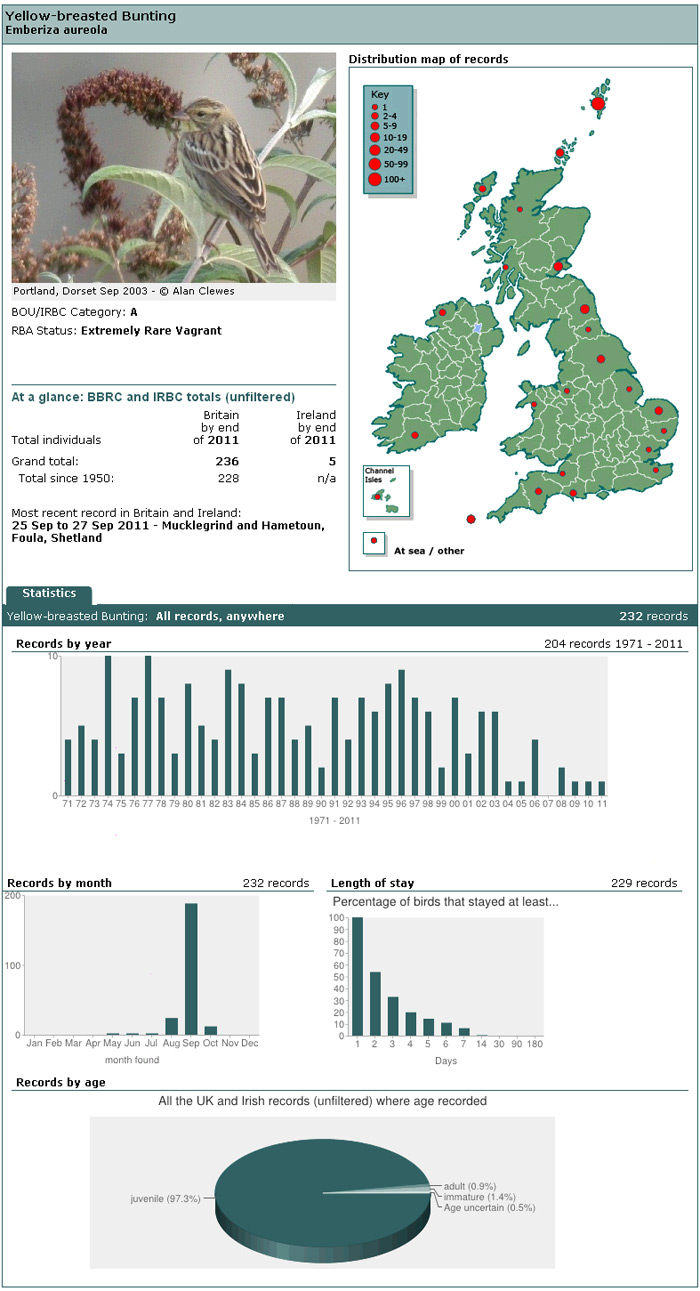
A dozen hardy souls took a chance the next day, on a beautiful, if chilly, north Norfolk morning ~ blanks all round but what a super place to be…
Now we have to land ourselves at the “belated news” door ~ behind which comes a first-winter female Dusky Thrush seen in gardens on a housing estate in Brixham (Devon). Found on October 26th and present to November 2nd, the bird showed well on occasion but it was decided that news would not be released, other than to a few locals Torbay birders ~ with the look-a-likey in Kent being one reason listed as to the news “lock-down”. Thank goodness for The Garden of England said many…
The similarity between the Devon and Kent birds hasn’t gone unnoticed ~ so that’s what they look like generally then? Both pure? Both hybrids? One better than the other? One obviously six months older etc., etc., etc. You know where you can read all about that stuff…enjoy…
These scenarios, involving such a massive, still highly prized rarity, will always rankle many, especially in a week when a similar happening has been so beautifully managed in Wales. Some you win, some you lose. A little bit like the Tiree Cedar Waxwing earlier in the autumn, it is perhaps galling to many to see great images of the bird, knowing that circumstances prevented an all-out twitching bunfight ~ Tiree perhaps easier to swallow, being an off-island. Then again, the online bickering and ignored pager requests post the Welsh Warbler may give the Thrush finder every reason to think they made the right call.
As has been touched on before here, plenty of examples exist of really tough situations being resolved to everyone’s pleasure ~ this week’s Western Orphean Warbler, the Cley White-crowned Sparrow, the Kent Golden-winged Warbler (remember too, the irony of a Common Yellowthroat being found and suppressed in the same county at the same time), but hordes of birders aren’t everyone’s cup of tea. I may not like, you may not like it, but that’s how it is. And always will be.
We’ll wrap this section with less-controversial news ~ let’s celebrate the exciting flock of Two-barred Crossbills found in the Forest of Dean, at Kensley Lodge near Cinderford on 16th. Initially there were five birds (three males) and the figure moved to seven a couple of hours later with nine following soon afterwards and before noon, they total was at 15 (a flock that included eight males). Less than an hour later they’d peaked at 17 ~ wow! Fantastic stuff and just one short of the recent record of 18 on Sumburgh Head in August 2008. At least 14 were seen on 17th with a minimum of nine still there on 18th and eight (at least five of them males) on the final review day.
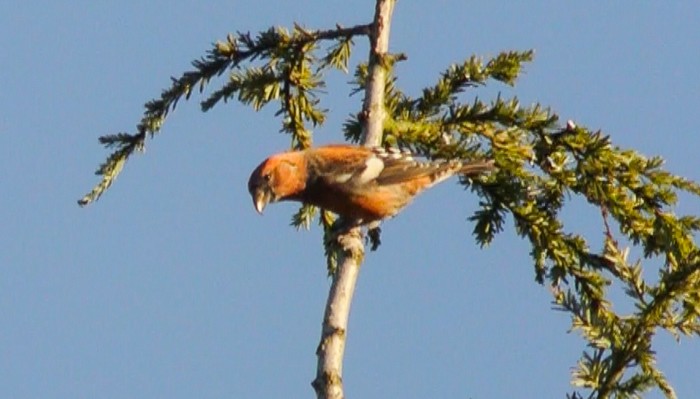
On Shetland, at least three White-billed Divers were noted around the islands this week ~ one remained off Kirkabister, Mainland on 13th and the following day saw two seen in Bluemull Sound, between Yell and Unst. Three were reported in Galway, at Doonloughan on 8th but there was no sign of any over the past few days.
A Leach’s Storm-petrel was noted heading past Porthgwarra on 14th and on 15th another spent over an hour skittering around a fairly calm sea at Cley, where a Grey Phalarope was also recorded on the same entertaining little seawatch.
Further Grey Phals were seen at Burniston Long Nab (North Yorkshire), Porthmadog (Gwynedd) and Carnoustie (Angus), all on 14th, the latter of which was still present on 17th when another was noted at Musselburgh (Lothian), while the inland bird at Devon’s Roadford Reservoir remained to 15th.
A total of 12 Pomarine Skuas were noted from five well spread counties this week (Cornwall, Dorset, Suffolk, Argyll & Bute and Mayo) and a late Sabine’s Gull was noted off Scillonian III on 18th.
All bar one of the 48 Balearic Shearwaterslogged this week were seen in Cornish waters ~ with 27 seen from Scillonian III on 15th the only double figure count from the past seven days. Porthgwarra, Porthcurno, St. Ives and Sennen all saw birds pass by, while Dorset’s Portland Bill recorded one on 17th.
With a bit of Arctic air forecast for the end of the review period, there were hopes for a few more Little Auks ~ a species that’s been in short supply this autumn so far. By the end of the weekend just six had been noted, one from Porthgwarra on 14th, two from Thorpeness (Suffolk) and one at Kilnsea (East Yorkshire) on 15th with a somewhat distracted set of birders on North Ronaldsay managing to see two pass by on Dowitcher Day.
A wonderfully uninhibited first-winter Glossy Ibis spent the afternoon of 16th on the NWT reserve at Cley before heading a little further east (apparently after rather too much chitter-chatter in Wiggy Hide) to the side of the A149 at Salthouse, performing incredibly by the duckpond for a while before heading east once more as dusk came in. Aside from the quartet that flew by earlier this autumn and the foursome that journeyed from Oxfordshire to north Norfolk in September 2002, this is the first Glossy Ibis to land on the reserve since the fabulous summer adult dropped in to the Bittern Pool in May 1992.
The week began with five single Ibis still in place from previous days ~ at Lowdham (Nottinghamshire), at Bowers Marsh RSPB (Essex), over Minsmere RSPB (Suffolk), at Welney WWT (Norfolk) and still on Rye Meads RSPB (Hertfordshire) with a new arrival noted at Cliffe Pools RSPB (Kent) the same day.
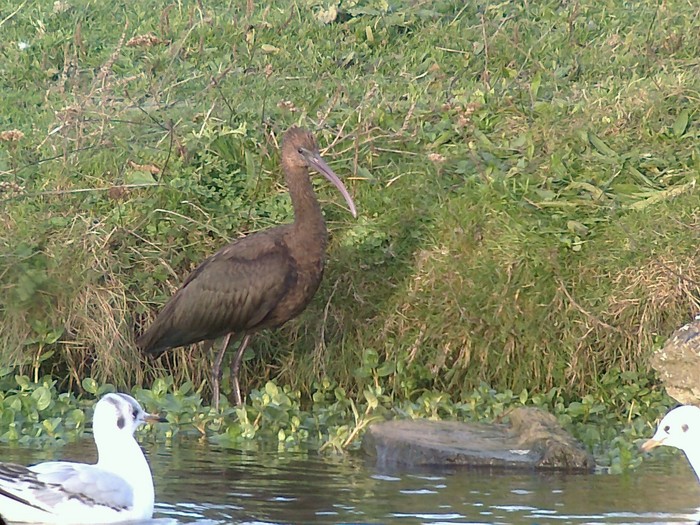
In Gloucestershire, the two juvenile Glossy Ibis were again at Slimbridge WWT from 14th, popping in along the River Severn at Purton on 16th, with further singles noted again at Holland Haven (Essex) on 14th, Dungeness RSPB (Kent) on 15th, the Cam Washes (Cambridgeshire) on 16th and Chilwell (Nottinghamshire) on 17th.
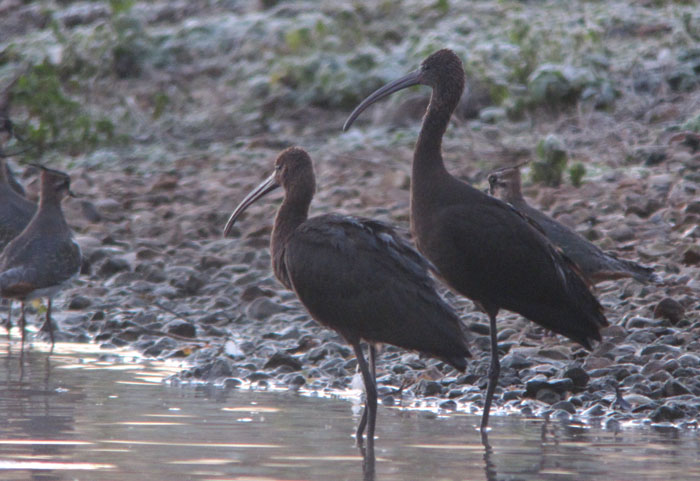
The adult Cattle Egret remained around the north Kent marshes, between Harty Ferry, Sheppey and Oare Marshes to 17th at least and on 19th, singles were reported over Margate cemetery and also at Grove Ferry NNR.
This week’s total of Great White Egrets mustered some 23 birds ~ running through the regions, the Northeast saw two remain at Hornsea Mere (East Yorkshire) to the weekend at least with one reportedly still present at Swillington (West Yorkshire) on 13th. East Anglia’s only representative was one still at Lakenheath Fen RSPB (Suffolk) to 16th. In the southeast of England, a minimum of two were at Dungeness RSPB with old-faithful still around Blashford Lakes HWT (Hampshire) at the start of the week with another in Buckinghamshire on 19th.
The Westcountry saw a single bird appear at Coate Water Park (Wiltshire) on 16th and the southwest’s sole offering was one flying past Portland Bill on 17th. In the Midlands, three were again at Pitsford Reservoir (Northamptonshire) over the weekend (with a single elsewhere in the county on 19th) and one was again at Nottinghamshire’s Idle Valley reserve on 13th.
The northwest of England logged a minimum of five ~ two for the Southport area and three at Ince Marshes, near Frodsham, while Wales scored four ~singles at Llangorse Lake (Powys) on 13th-15th and Burry Port (Carmarthenshire) on 17th with two again at Llanrhidian Marsh (Glamorgan) on 15th.
At least 20 Spoonbills were still lurking in Poole Harbour this week with new singles noted at Blarney Bog (Co. Cork), Castle Espie WWT (Co. Down) and Slapton Ley (Devon) on 14th. Up in north Devon, two remained on the Taw Estuary to 17th while in southeast Cornwall, three were on the River Lynher on the same date. Also new were two at Pegwell Bay (Kent), seen there on 16th while lingerers remained at The Cunnigar, Dungarvan (Co. Waterford) to 16th and in Pagham Harbour (West Sussex) to 17th.
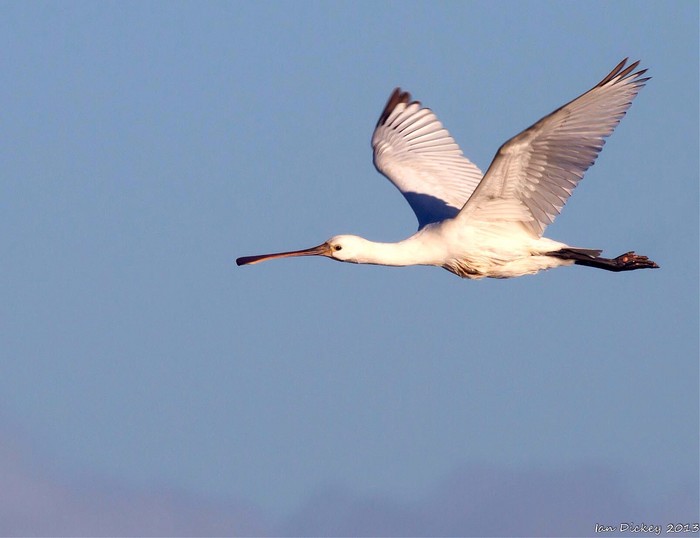
In the Norfolk Broads, 25 Common Cranes were noted over Billockby (you’ve got to be careful typing that one…) on 13th and then at the Stubb Mill roost on 16th, with smaller splinter flocks noted around Horsey Mere and Horsey Gap later in the week. Over in Cambridgeshire, nine birds remained at Guyhirn at the start of the week, with three at the Nene Washes on 19th and three were still at Lakenheath Fen RSPB on 13th.
Finally for this section, some surprise news from the Arundel WWT reserve in West Sussex where the Spotted Crake last recorded there on October 24th was noted again this week, seen on 17th. Where’s that been hiding?Off the Scottish coast on Islay, a Richardson’s Cackling Goose was noted again at Loch Gruinart RSPB on 18th while the Grey-bellied Brant-type continued to show to all interested parties at Kilbarrack (Co. Dublin) to 17th at least (it’ll be there for the winter), while at Sandy Bay (Co. Kerry) a new Black Brant was found on 17th, following on from another new arrival in Dorset’s Christchurch Harbour on 13th.
Elsewhere further Brants remained at Cley, Dawlish Warren and Raghly (Co. Sligo) ~ all present on 13th ~ with singles also seen at Farlington (Hampshire) on 14th, Ferrybridge (Dorset) on 15th (with two there again on 17th) and Two Tree Island (Essex), also on 17th. The usual Red-breasted Goose was around Milford-on-Sea (Hampshire) for much of the week (and the yellow-ringed bird remained in Cumbria too).
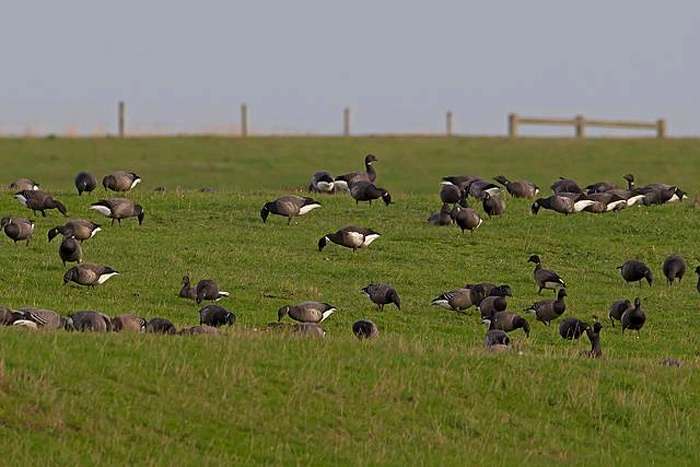
A first-winter Ross’s Goose ~ incorrectly reported as a hybrid last week, so omitted from the round-up ~ was still at Marshside RSPB (Lancashire) on 13th (having first been noted on 9th). The bird remained in the area until at least 17th but has now been labelled as an escape and, given the age of the bird, is perhaps yet another nail in the Category A acceptance coffin for this, now, extremely common species on the US side of the Atlantic.
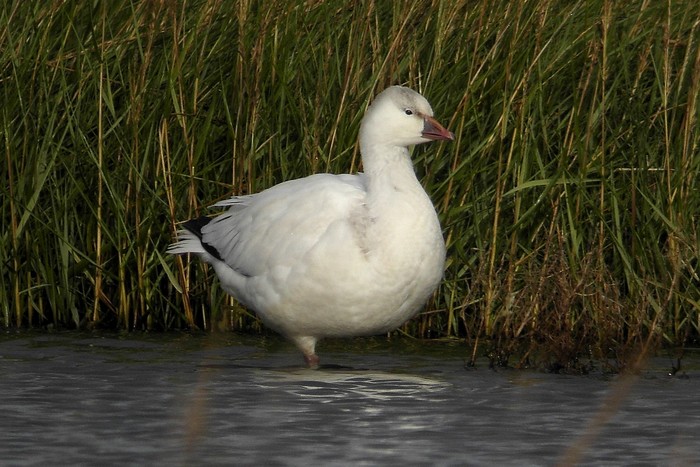
Such an irony that this species, as it has increased rapidly in North America, has duly been logged with wild geese here over the same decade or more (the first-winter in Norfolk at the start of the 2000’s always had a fantastic feel-good factor for instance) but it has always been batted away at committee level and will, presumably, continue to be so. Compare that with Hooded Merganser and it really makes no sense at all.
No such qualms with the wintering pair of Lesser Snow Geese that remained at Tayinloan (Argyll & Bute) to 13th or the two blue Snows that were again in the goose roost at Loch of Skene (Aberdeenshire) on 13th and 15th. Kerry’s white morph remained at Carrahane Starnd to 19th.
A young drake Blue-winged Teal continued to hang around Boultham Mere (Lincolnshire) to 14th while drake Green-winged Teals remained at Rutland Water (Leicestershire), Caerlaverock WWT (Dumfries & Galloway) and Loch Gruinart RSPB, Islay (Argyll & Bute) from 13th with further birds logged on North Ronaldsay on 15th and Loch of Kinnordy RSPB (Angus) and (back again) at Portworthy (Devon) both on 17th.
In Kerry, the drake Lesser Scaup was still on Lough Gill on 17th with the first-winter female remaining at Murlach, Ballyconneely (Co. Galway) to 18th, when the drake was still noted as present on Chew Valley Lake (Somerset). The latter site also remained host to a drake Ferruginous Duck on 16th when another was seen at Dungeness RSPB ~ it could be the first Kent record in almost five years, since a one day drake at Westbere in December 2008.
The only Ring-necked Duck reported this week was the female-type on Eyebrook Reservoir (Leicestershire) on 15th-18th while just two drake American Wigeons were seen ~ still at Udale Bay (Highland) on 15th-19th and Loch of Strathbeg RSPB (Aberdeenshire) on 16th.
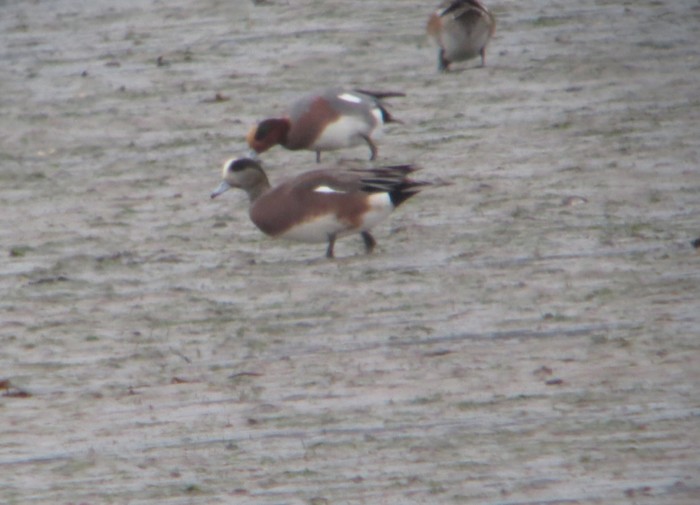
The drake King Eider was at Burghead Bay (Moray) to 15th while Surf Scoter records came from Brand’s Bay, Poole Harbour (Dorset) ~ the juvenile present all week ~ Llanddulas (Conwy) ~ two drakes there to 16th at least ~ and also at Ardivachar, South Uist (Outer Hebrides), a juvenile there on 13th, Morfa Bychan (Gwynedd), a female there on 15th, still off Dungarvan (Co. Waterford) on 16th, at The Wig, on the side of Loch Ryan (Dumfries & Galloway), a returning drake there on 17th, with the same date also seeing a drake noted from Shell Island (Gwynedd) and also a juvenile drake off Garretstown (Co. Cork). The final bird this week was found near Kinvarra Co. Galway) on 19th to make a grand total of ten in all.
The first-winter Semipalmated Sandpiper found last week in Lancashire remained at Pilling Lane End until 13th. A juvenile White-rumped Sandpiper was still on the Hayle Estuary to the same date while the adult at Frampton Marsh RSPB in Lincolnshire stayed all week.
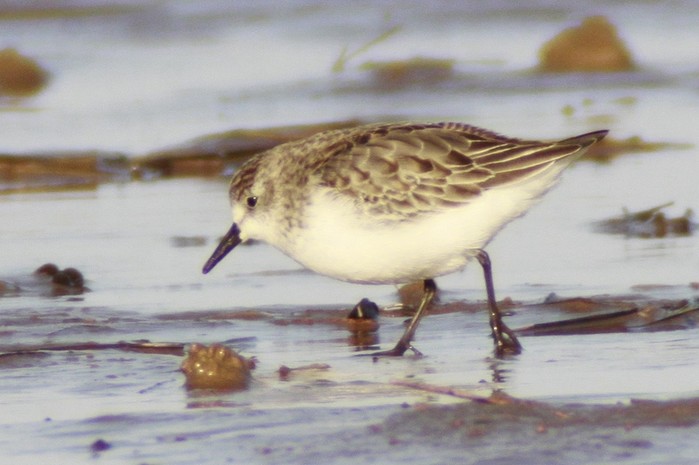
A new American Golden Plover was in fields near Sennen (Cornwall) on 17th-18th with the second of the week still at Ballycotton (Co. Cork) on 16th=-17th. Hampshire’s double act of nice’n’rare American shorebirds continued to linger in the county ~ the adult Long-billed Dowitcher at Keyhaven Marshes to 19th while the Lesser Yellowlegs at Lepe CP went to the same date.
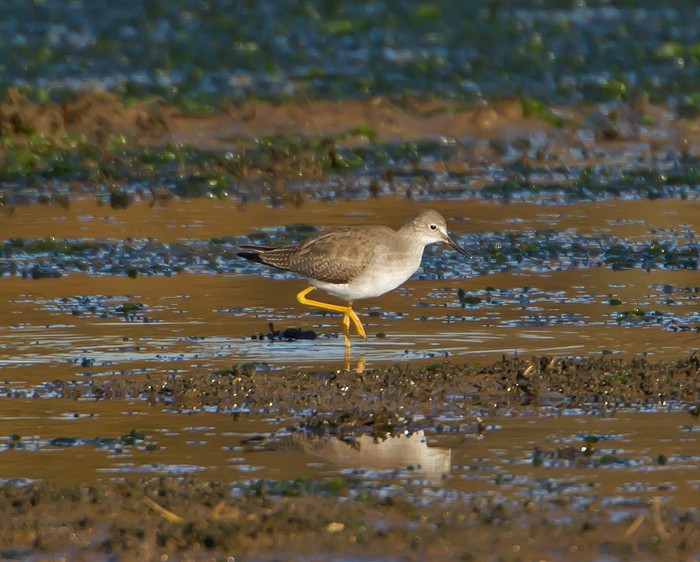
The wintering adult Bonaparte’s Gull in south Devon spent most of its time this week off Dawlish Warren while the adult in Northumberland was seen again off Stag Rocks, Bamburgh on 16th before relocating back to Farnes on 18th.
A striking new adult Kumlien’s Gull was at Ross Beach (Co. Galway) on 13th with numbers of Iceland Gulls jumping to double figures ~ two different juveniles were around Peterhead (Aberdeenshire) on 16th-17th with English east coast birds noted at Kilnsea and Easington (East Yorkshire) on 13th, Scarborough (North Yorkshire) on 15th and Newcastle (Northumberland) on 16th. Back up north, singles on Shetland were on Fair Isle on 14th and near Lerwick on 16th and on Orkney, at Westray on 19th, with Irish singles logged at Calddagh beach (Co. Galway), Tralee Bay Wetlands Co. Kerry) and Liscannor (Co. Clare) during the week.
Glaucous Gulls went just one better this week ~ 12 reported with six of those in northern Scotland, five of them on Shetland. Two were seen at Lerwick on 15th, two more were on Fair Isle on 16th and one was at Sumburgh on 17th while a single bird was also at Peterhead on 16th. A juvenile remained North Hykeham (Lincolnshire) to 16th while the juvenile at Edgefield remained to 18th at least (popping in to Cley occasionally ahead of a roost off the coast ~ interestingly, along with the Glauck and Thayer’s-thingy, two separate “Viking Gulls” have also been noted around the north coast ~ a first-winter at Salthouse and Cley on 14th and 18th, with a second-winter at Edgefield on 16th).
Another young Glaucous was seen at Lowestoft (Suffolk) over the weekend, with new singles at Hornsea (East Yorkshire) and Chasewater (Staffordshire) on 19th and in Ireland, singles were at Tralee and off the Waterford coast on 16th.
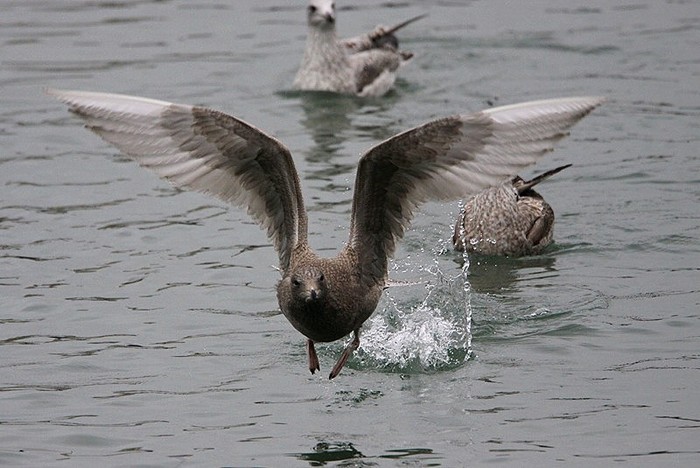
Staying at Tralee, the returning second-winter Ring-billed Gulls was still present on 16th, while an adult was “new” in County Dublin, seen at the Santry River outflow on 13th. A first-winter was at Kerry’s Ross Castle on 19th and regular adults remained at Gosport (Hampshire), Nimmo’s Pier (Co. Galway) and Carrickfergus (Co. Antrim) through various bits of the week.
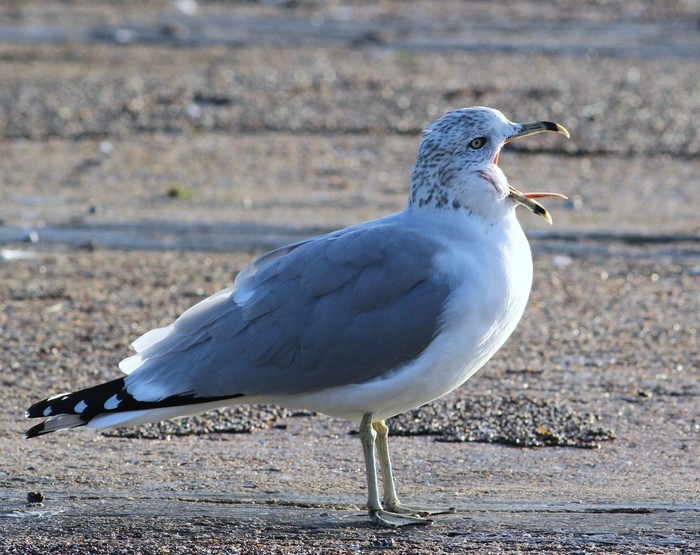
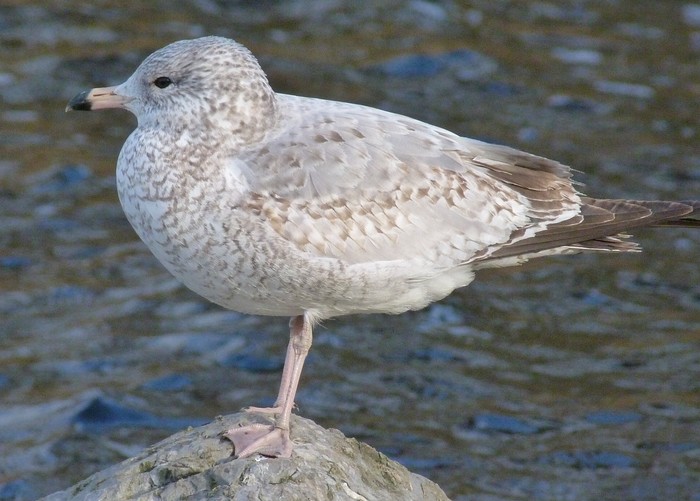
Not normally known for making any sort of an appearance in the rares roundup is Mediterranean Gull ~ but news of around 1,000 around The Fleet (Dorset) on 18th is irresistible. Anyone in to their gulls will know that Meds absolutely rock…so a count of epic four figure proportions warrants a heads-up here.
The white Gyrfalcon noted last week on North Uist made another fly though around the Baleshare area on 17th. Rather less seasonal was the Black Kite that courted the southeast of England for a few days this week ~ seen first at Dungeness on 13th, it was then noted at Rye Harbour in neighbouring East Sussex on 14th before being seen back at Dungeness on 16th-17th where it was last seen heading high and east over the ARC Pits. The following day what must have been the same bird was seen between Hamstreet and Ashford.
/gyr_falcon_craig_hastain_crop.jpg)
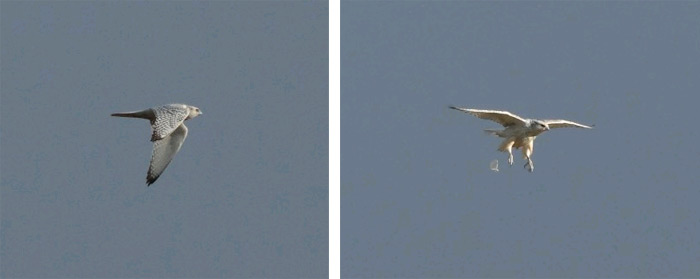
Aside from the ever-present wintering Rough-legged Buzzard at Suffolk’s Orford Ness, the only other individual noted this week was on Foulness Island (Essex) on 16th.
Just as the light was starting to fade on another week, came a surprise report of a Snowy Owl on the golf course at Felixstowe (Suffolk). First thought, “ship-assisted”, just like the last one in the county, the oily-looking first-winter male that was found in the nearby docks on October 24th 2001 ~ remaining in the area until December. However, news came after dark that an escaped Snowy has been noted in the area recently, so that was that…
November Lesser Grey Shrikes remain a rare-beast indeed and this week’s bird in Northumberland, at Long Nanny, near Beadnell, will be only the sixth-ever for the month. Found on 13th, it was eventually identified correctly on 15th and remained in place to 19th. This is the second record of the species in the county this year, following on from the summer adult on Holy Island in May to take Northumberland’s overall total to 11.
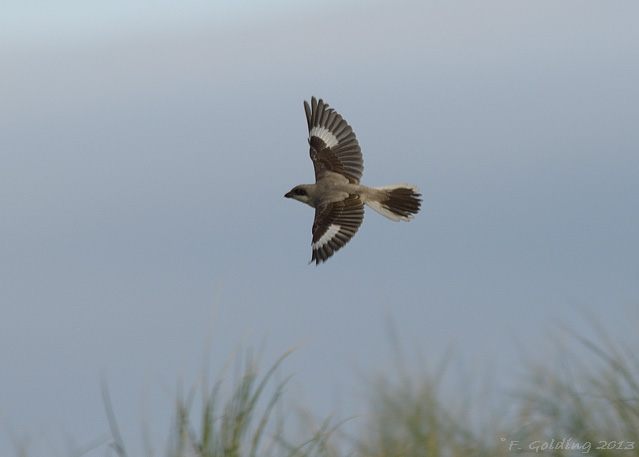
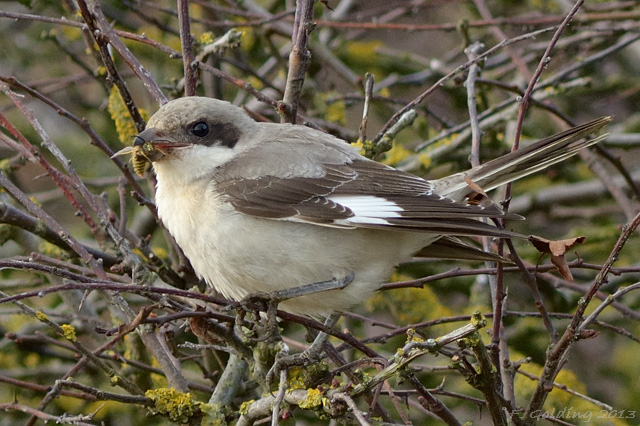
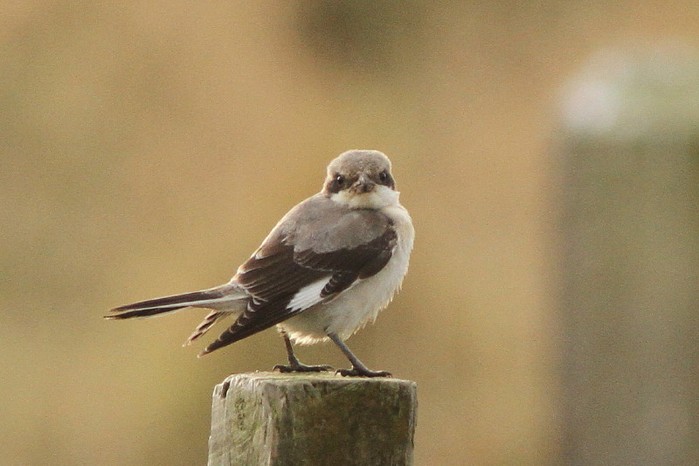
Previous November records date from 1851 (on Scilly), 1940 (seen on Fair Isle), 1962 (one on Orkney), in 1973 (a dying bird in Surrey) and, most recently, a well-twitched bird in Durham in 1984, present at Jarrow for 12 days from November 17th-28th.
Two Siberian Stonechats were idenitifed this week, hundreds of miles apart at either end of the country. A first-winter firmed up on Westray (Orkney) on 13th (having been suspected a couple of days beforehand) and remained to 16th while a young male was found on Castella Down, St. Agnes (Scilly) on 17th. Also feeling a little late in the day was the first-winter male Serin that arrived at Flamborough Head (East Yorkshire) on 13th, where it remained to 19th. A heard-only bird was also reported from Cambridgeshire on 18th.
Actually, while we’re at it, let’s mop up a few other late, late showers ~ a Hoopoe was reported from Aber Ogwen (Gwynedd) on 14th, a female-type Golden Oriole was at Island Hill, neat the Comber Estuary in County Down on 15th, when a Red-backed Shrike was seen near the Gugh Bar on St. Agnes while a Wryneck appeared at Sennen Cove (Cornwall) on 17th.
The long-staying Spurn Barred Warbler stayed in place until at least 17th while another bird possibly eyeing up a lengthy stay was the second bird of the week, still at Fethard-on-Sea (Co. Wexford) to 16th.
On St. Mary’s three Yellow-browed Warblers remained around Porth Hellick on 13th and was followed by single birds on Lower Moors on 14th, the Garrison on 16th with three on the former part of the island on 17th. Across the water on the Cornish mainland, four singles were found ~ at Cot Valley on 13th and 16th, at Porthcurno on 15th-16th and Church Cove, Lizard on 17th, with four others noted elsewhere in Britain, at Angle (Pembrokeshire) and Margate (Kent) on 13th, Lundy (Devon) on 17th, at Dungeness (Kent) on 18th and Caldecotte Lake (Buckinghamshire) and Clennon Valley Lakes (Devon) on 19th.
In East Sussex, the Red-breasted Flycatcher remained at Pevensey Levels to 14th while a new first-winter was a surprise find on the fence line near the car park at Cley beach on 16th.
The first day of the new review period (13th) saw Richard’s Pipits noted over Sker Point (Glamorgan) and Aber Ogwen (Gwynedd) with two noted at Porthgwarra (Cornwall) on the same date. Another single spent a couple of days around Portland Bill (on 14th-15th) and on 16th, new birds were noted at Spurn (East Yorkshire) and Halstow Marshes (Kent). Three more were to follow ~ on 17th, birds were logged at Orcombe Point (Devon) and on Fair Isle (Shetland) with another Dorset bird seen at Abbotsbury on 18th. As the week drew to a close a remarkable report of at least four Richard’s Pipits came from east Norfolk, the birds present in the dunes at Winterton.
Around 22 Great Grey Shrike were recorded this week ~ birds were noted at four different sites in Nottinghamshire during the week, with four more in the Midlands (stretching from Staffordshire and Shropshire to two in Derbyshire). Two birds were seen at Coldwaltham (West Sussex) on 13th-15th and two more were still in close proximity in the Yaxley area of Cambridgeshire.
It was as you were for many of the others noted through the past few days, already familiar birds on wintering sites, though the birds at the Gloucestershire Two-barred Crossbill site (on 16th-18th) and near St. David’s (Pembrokeshire) were certainly worth picking out from the rest of the crowd. Others were noted from South Yorkshire to Devon and Powys (two there) to Norfolk.
Staying in Norfolk, the only Rose-coloured Starling reported this week was the first-winter at Caister-on-Sea, still there to 19th, while the popular gathering of Parrot Crossbills in Holt Country Park was a draw for many over the weekend and beyond, a dozen still noted ~ generally still moving around as a 10 and a 2, though sometimes coming together ~ and causing people problems if the online chatter is to be interpreted correctly.
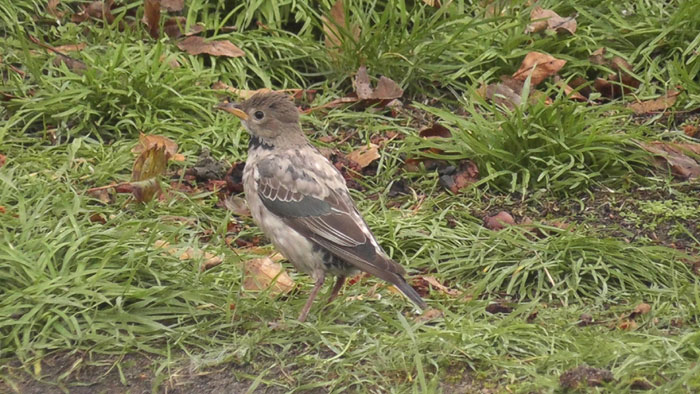
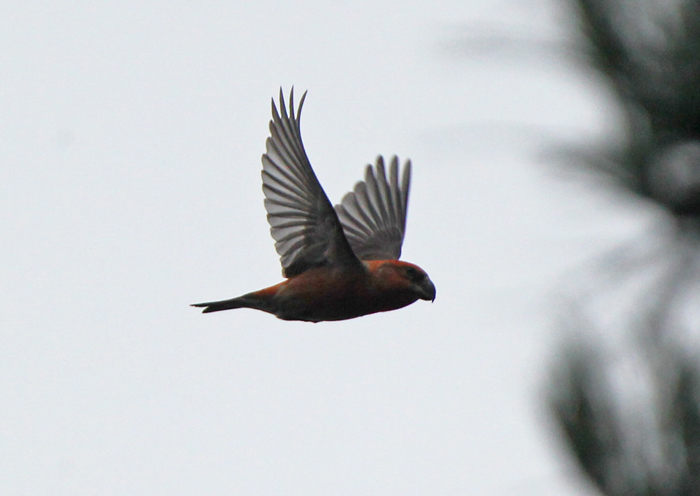
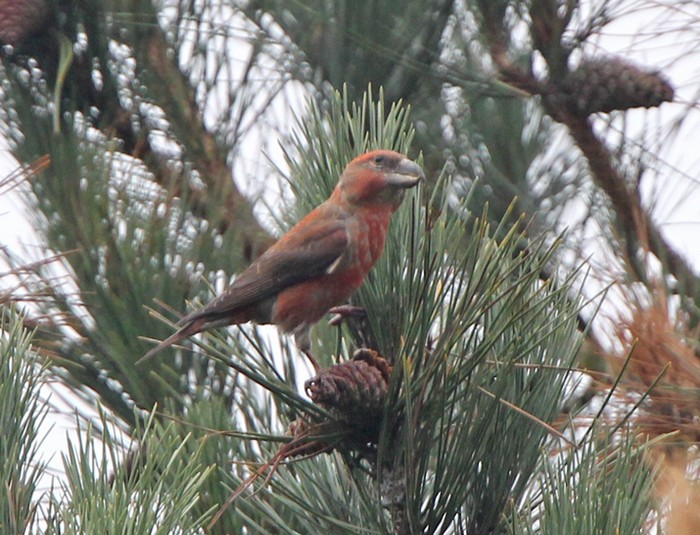
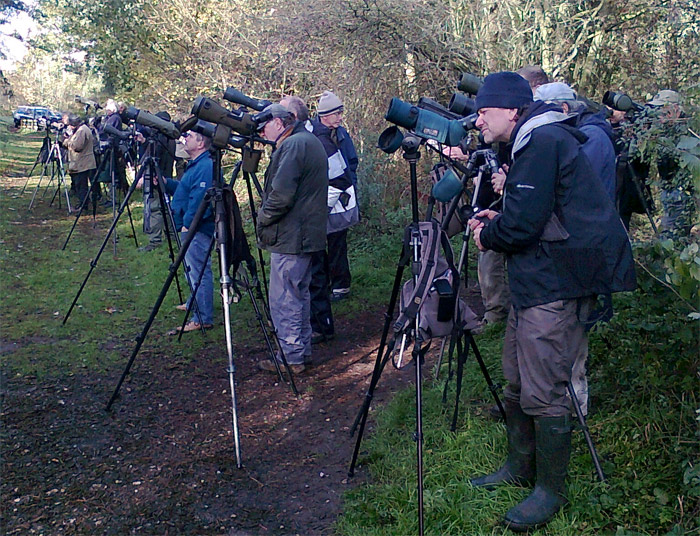
The birds were generally noted demolishing cones near the car park, so making for an easy, if noisy twitch (cars and birders included). Adding to the fun, the big-billed flock of Continental Crossbills which have also been seen in the area this week ~ also numbering 12. Which is handy…
There’s more to these Crossbills than meets the eye y’know…
Also in Norfolk, a male Two-barred Crossbill remained at Lynford Arboretum to 17th with further birds noted on the same day coming from another Broomshead Reservoir (South Yorkshire) ~ that one was heard only ~ while in Surrey, the female remained at Leith Hill and Kent’s male was still at Hemsted Forest. The latter site also continued to play host to two Parrot Crossbills too, with at least one noted in the New Forest, at Slufter’s Inclosure, on 19th.
Finally, to Waxwings. Scotland again laid claim to most birds this week, though far fewer were reported this week ~ a minimum of 30 were in Elgin (Moray) on 15th with 25+ at Fochabers (also in Moray) on the same day. In Aberdeenshire 35 were seen at Bridge of Don on 17th. West and South Yorkshire saw one each, two were in North Yorkshire and Norfolk logged one too. A flock of 30 over Belper (Derbyshire) was a little surprising given how few have been reported so far this autumn, but more surprising still was the gathering of 50 reported from Croham Hurst (London) on 16th.
The chilly weather is set to last a little while by the look of it, so will we see any benefit in the birds that may move around it? Dreams of northern owls always loom large and I for one would welcome another go at a certain chunky northern finch...
The week ahead has been productive in terms of the rare birds that have appeared over the years ~ but there are three that stand out from three very different birdwatching eras...
Most recently, the Fregatta petrel, most likely a Black-bellied Storm-petrel, that was seen well after fierce storms spun through the Western Approaches and dropped it in the Severn Estuary on November 25th 2009.
Heading back to the beginning 80’s and to the River Exe, where the wintering Hudsonian Godwit was first noted on November 22nd 1981. This one still stands the test of time ~ and the longer it does so the better (!) ~ this was the first bird I bunked off school for...32 years on and the question of which was the better option ~ a slightly better Geography “O” Level grade or a long-standing gripper ~ really doesn’t need to be answered.
Of course, there is one even-longer standing superstar, way beyond the quailty of Hudwit, that is coming up to 51 years and counting...Suffolk’s Houbara.
Found near Hinton on November 25th 1962, some readers out there were fortunate enough to enjoy this incredible bird ~ the few images of the big turn out show many gents in suits, ties and general Sunday best with the ladies in theirs for good measure...that deliciosuly quaint scene is as unlikely to be repeated as the arrival of another Macqueen’s Bustard is.
Mark Golley
20 November 2013
Special thanks this week to Dave Astins for his insight in to the Pembrokeshire Western Orphean Warbler. Many thanks also to Mark Warren and the staff of North Ronaldsay Bird Observatory for allowing us to use shots of their super Short-billed Dowitcher.
Dave Hutton, Mark Hipkin, Paul Lifton, Paul Rowe, Richard Stonier, Pete Hines, Paul Hindess, Mark Warren, Alan Tate, Nic Hallam, Dermot Breen, Alan Clewes, Gus Guthrie, James Less, Ian Dickey, Paul Brewster, Toby Green, Stuart Piner, David Potter, Chris Baines, Neil Cowley, Davey Farrar, Steve Duffield, Frank Golding, Rob Stonehouse, Joh Hall, Murray Smith, Sean Nixon.








